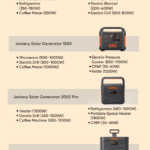Disclosure: This post contains affiliate links and I will be compensated if you make a purchase after clicking through my links. Learn More
Let a generator cool for at least 15 minutes before refueling. Generators need this time to cool down and prevent injuries or equipment damage due to hot surfaces.
Generators are commonly used for providing electricity during power outages or in remote locations. However, refueling a generator requires some precautions to ensure safety and proper functioning. One essential step is to allow the generator to cool down for a sufficient amount of time before refueling.
This cooling period, typically around 15 minutes, allows the generator’s components and surfaces to cool off and reduce the risk of injuries or equipment damage caused by hot surfaces. We will explore the reasons behind the cooling period and provide some additional guidelines for safe generator refueling.
Importance Of Allowing Sufficient Cooling Time
When it comes to owning a generator, it’s crucial to understand the importance of allowing sufficient cooling time before refueling. Failing to do so can lead to serious risks and potential damages. In this section, we will discuss why it is necessary to let your generator cool down before refueling and the potential risks associated with refueling a hot generator without giving it proper cooling time.
Why Is It Necessary To Let Your Generator Cool Down Before Refueling?
Refueling a generator may seem like a straightforward task, but the consequences of not adhering to proper cooling time can be significant. Here are a few reasons why it is necessary to let your generator cool down before refueling:
- 1. Avoiding Fuel Ignition: Generators produce heat during operation, and the engine can become extremely hot. If you refuel a hot generator, the fuel vapors can ignite, leading to a potentially dangerous situation. It is essential to allow for sufficient cooling time to minimize the risk of fuel ignition and subsequent accidents.
- 2. Preventing Engine Damage: When a generator is running, the engine’s components, such as pistons and valves, can experience intense heat. Refueling a hot generator can introduce a sudden temperature change, causing thermal shock to these components. This thermal shock can lead to severe engine damage and may result in costly repairs or even the need for a replacement.
- 3. Ensuring Optimal Performance: Allowing your generator to cool down before refueling ensures that it operates at its maximum potential. When the generator is hot, the fuel evaporates more quickly, reducing the overall fuel efficiency. By giving it sufficient cooling time, you can improve its efficiency, prolong its lifespan, and ensure it delivers optimal performance when needed.
The Risks Of Refueling A Hot Generator Without Giving It Proper Cooling Time
The risks associated with refueling a hot generator without giving it proper cooling time cannot be overstated. Here are some of the potential dangers:
- Fuel Ignition: As mentioned earlier, refueling a hot generator increases the risk of fuel vapor ignition. This can lead to explosions, fire hazards, and severe injuries. It is crucial to prioritize safety by allowing the generator to cool down before refueling.
- Engine Malfunction: Refueling a hot generator can cause thermal shock to the engine, leading to malfunctions, breakdowns, and even complete engine failure. Replacing or repairing a damaged engine can be costly and time-consuming, making it imperative to give the generator adequate cooling time.
- Personal Safety: Neglecting cooling time can pose a threat to personal safety, not just from fuel ignition or engine malfunctions. The generator’s external components, such as the exhaust pipe, can also become dangerously hot during operation. Touching or handling these hot components can result in severe burns. By allowing sufficient cooling time, you can reduce the risk of accidental injuries.
Ensuring you let your generator cool down before refueling helps minimize potential risks, avoid costly damages, and extend its overall lifespan. Safety should always be the top priority when handling generators or any other equipment.
Understanding The Cooling Time Required
Understanding the Cooling Time Required
When using a generator, it is essential to understand how long to let it cool down before refueling. This cooling period not only ensures the safety of the operator but also prolongs the lifespan of the generator. Ignoring the cooling time can result in accidents and damage to the generator.
In this section, we will delve into the factors that determine the cooling time required, the different generator types, and their cooling requirements, as well as the ideal cooling time for various generator sizes.
Factors That Determine How Long You Should Let Your Generator Cool Down
The cooling time for a generator is influenced by several factors. These factors include the operating temperature, load capacity, and runtime. Let’s look in more detail:
1. Operating Temperature
Generators tend to get hot while running, especially during extended periods of operation. The higher the operating temperature, the longer the cool-down time required. Generally, a generator should be allowed to cool down for at least 15-30 minutes after being shut off to reach a safe temperature for refueling.
2. Load Capacity
The load capacity of a generator also affects the cooling time. If a generator has been running at maximum capacity, it generates more heat and therefore requires a longer cooling period. High loads increase the internal temperature of the generator and necessitate a longer cool-down time, typically around 30 minutes or more.
3. Runtime
The duration of the generator’s runtime is another crucial factor to consider. Long-running generators accumulate heat that needs to dissipate before refueling. If the generator has been operating for several hours, it is advisable to extend the cooling time to allow the engine to cool down adequately. A cooling period of 30 minutes to an hour is recommended for generators with extended runtimes.
Different Generator Types And Their Cooling Requirements
Generators come in various types, each with its cooling requirements. Here’s a breakdown of some common generator types:
| Generator Type | Cooling Time Required |
|---|---|
| Portable Generators | 15-30 minutes |
| Inverter Generators | 15-30 minutes |
| Standby Generators | 30 minutes to 1 hour |
| Industrial Generators | 1 hour or more |
The Ideal Cooling Time For Various Generator Sizes
Generator size also plays a role in determining the cooling time required. Larger generators generally produce more heat and thus require a longer cooling period. Here’s a guideline for the ideal cooling time based on generator size:
Small generators (1-5 kW)
Allow the generator to cool down for 15-30 minutes before refueling.
Medium generators (5-10 kW)
Extend the cooling time to 30 minutes to an hour to ensure the generator reaches a safe temperature.
Large generators (10 kW and above)
These powerhouses need a cooling period of 1 hour or more due to their higher heat output.
By adhering to these cooling times, you can ensure the safe operation and optimal performance of your generator. Always prioritize safety and maintenance to get the most out of your generator’s lifespan.
Essential Tips For Proper Cooling
Tips For Maximizing Cooling Efficiency And Reducing Waiting Time
Proper cooling is essential for the optimal functioning and longevity of your generator. By following these tips, you can maximize cooling efficiency and minimize the waiting time before refueling:
- Choose the right location: Place your generator in a well-ventilated area that allows for proper air circulation. Avoid confining it in small, enclosed spaces as this can hinder cooling efficiency.
- Clean the air intake: Regularly clean the air intake filters to remove any dust or debris that could restrict airflow. This will improve cooling efficiency and prevent overheating.
- Keep a safe distance: Ensure there is ample space between your generator and any walls or other objects. This allows for unrestricted airflow and prevents the recirculation of hot air.
- Utilize natural ventilation: If possible, position your generator near a window or door to take advantage of natural airflow. Opening these ventilation points while the generator is running will help dissipate heat more effectively.
- Consider additional cooling methods: In situations where ambient temperatures are particularly high or if you require extended generator runtime, you can use external cooling devices like fans or ducting to enhance cooling efficiency.
- Monitor coolant levels: Regularly check the coolant levels in your generator and top them up as needed. Insufficient coolant can hinder the cooling system’s effectiveness.
- Maintain fuel levels: It’s important to keep your generator’s fuel tank at least half full. This ensures a steady fuel supply and prevents sudden shutdowns during operation, which can disrupt the cooling process.
Common Mistakes To Avoid When Cooling Down Your Generator
While cooling down your generator, there are several common mistakes that you should be aware of and avoid:
- Refueling too soon: It can be tempting to refuel your generator immediately after turning it off, but this can be dangerous. Always allow sufficient time for the generator to cool down to a safe temperature before refueling.
- Neglecting the cooling system: Some generator owners overlook the importance of regular maintenance, including the cooling system. Make sure to adhere to the manufacturer’s recommended maintenance schedule to prevent cooling system issues.
- Blocking airflow: Avoid obstructing the airflow around your generator, as this can result in inadequate cooling. Never stack objects on top of it or cover it with items that could impede ventilation.
- Ignoring warning signs: If you notice any unusual noises, vibrations, or fluctuations in temperature during generator operation, it’s vital not to ignore these warning signs. Promptly address any issues to prevent further damage and maintain optimal cooling efficiency.
Recommended Maintenance Practices To Improve Cooling Efficiency
To enhance the cooling efficiency of your generator and extend its lifespan, consider implementing these recommended maintenance practices:
- Regularly inspect the cooling system: Check for any leaks, cracks, or blockages in the cooling system. Addressing any issues promptly will help maintain optimal cooling efficiency.
- Clean the radiator and fins: Over time, dust and debris can accumulate on the radiator and fins, hampering heat dissipation. Regularly clean these components to ensure efficient cooling.
- Test the thermostat: A malfunctioning thermostat can disrupt the cooling process. Periodically test and calibrate the thermostat to ensure it is accurately controlling the engine temperature.
- Inspect and replace coolant: Check the coolant levels and quality regularly. flush and replace it according to the manufacturer’s recommendations. This prevents mineral buildup and maintains proper heat transfer.
- Keep electrical connections clean: Over time, dirt and corrosion can accumulate on electrical connections, inhibiting their performance. Clean and inspect these connections regularly to maintain efficient cooling and overall generator functionality.
Ensuring Safety During The Refueling Process
When it comes to using a generator, safety should always be a top priority. One crucial aspect of generator safety is the refueling process. If not done properly, refueling a generator can lead to accidents, injuries, and even fires. In this section, we will discuss precautionary measures to take before refueling your generator, safe refueling techniques, and additional safety tips for handling and storing fuel correctly.
Precautionary Measures To Take Before Refueling Your Generator
Before refueling your generator, it’s essential to take certain precautionary measures to ensure your safety and the safety of those around you. These measures include:
- Turn off the generator: Before you even think about refueling, make sure to turn off the generator. This will prevent any accidental start-ups or electrical mishaps.
- Allow generator to cool down: Generators can become extremely hot during operation. To avoid burns or fire hazards, let the generator cool down for at least 15-20 minutes before refueling.
- Read the manufacturer’s instructions: Different generator models may have specific refueling instructions. Take the time to read the manufacturer’s instructions manual to understand any unique requirements or precautions for your specific generator.
Safe Refueling Techniques To Prevent Accidents And Injuries
Refueling a generator can be a potentially dangerous task if not done correctly. To prevent accidents and injuries, here are some safe refueling techniques to follow:
- Use the right fuel: Only use the type of fuel recommended by the manufacturer. Using the wrong fuel can damage the generator or even cause a fire.
- Avoid spillage: Carefully pour the fuel into the generator’s tank, avoiding any spills. Spilled fuel can not only be a waste but also a fire hazard.
- Keep away from open flames: Always refuel the generator in a well-ventilated area, away from any open flames or sources of ignition. This will prevent the risk of a fire or explosion.
- Use a funnel: To ensure a clean and precise pour, use a funnel when refueling your generator. This will help minimize spillage and reduce the chances of fuel coming into contact with hot engine parts.
Additional Safety Tips For Handling Fuel And Storing It Correctly
Proper handling and storage of fuel are crucial for maintaining generator safety. Here are some additional safety tips:
- Store fuel in approved containers: Use only approved containers specifically designed for storing fuel. These containers should be made of durable materials and have proper seals to prevent leaks.
- Label the containers: Clearly label the containers with the type of fuel they contain. This will help prevent confusion and ensure that the right fuel is used for the appropriate equipment.
- Store fuel in a cool, well-ventilated area: It is important to store fuel in a cool, well-ventilated space away from direct sunlight and heat sources. This will reduce the risk of fuel degradation and minimize the chances of a fire or explosion.
- Keep fuel away from children and pets: Store fuel in a secure location out of reach of children and pets. Accidental ingestion or contact with fuel can have severe consequences.
Following these precautionary measures, safe refueling techniques, and additional safety tips will help ensure a safe and accident-free refueling process for your generator. Remember, when it comes to generator safety, it’s always better to be proactive and take the necessary precautions.
FAQ For How Long To Let Generator Cool Before Refueling?
Do I Need To Let My Generator Cool Off?
Yes, it is important to let your generator cool off. This allows it to dissipate heat and prevent damage. Cooling off time varies depending on usage, but generally, 10-15 minutes is recommended. Regularly maintaining your generator ensures optimal performance and extends its lifespan.
Can I Fill My Generator With Gas While Its Running?
No, it is not safe or recommended to fill your generator with gas while it is running.
What Should You Do Before Refueling A Generator?
Before refueling a generator, follow these 5 steps for safety: 1. Turn off the generator and let it cool down. 2. Keep the generator away from open flames or sparks. 3. Use a grounded fuel container to fill the generator’s tank.
4. Avoid overfilling the tank and clean up any spills immediately. 5. Only use the recommended fuel type for your generator.
Can You Refuel A Hot Generator?
Yes, you can refuel a hot generator, but it is important to do so carefully to prevent any accidents or damage. Allow the generator to cool down for a few minutes before refueling to avoid the risk of fire or injury.
Always follow the manufacturer’s guidelines for safe refueling procedures.
Final Words
Allowing sufficient cooling time for your generator before refueling is crucial for its optimal performance and longevity. The recommended amount of time depends on the specific generator model and usage. By following manufacturer guidelines and implementing safety precautions, you can ensure that your generator remains in top condition and operates efficiently.
Remember to prioritize safety and proper maintenance to extend the lifespan of your generator.








